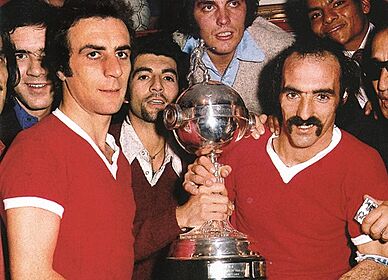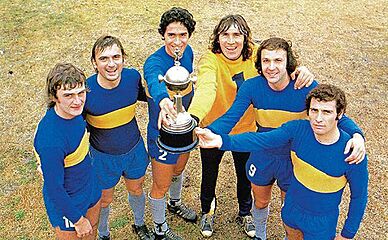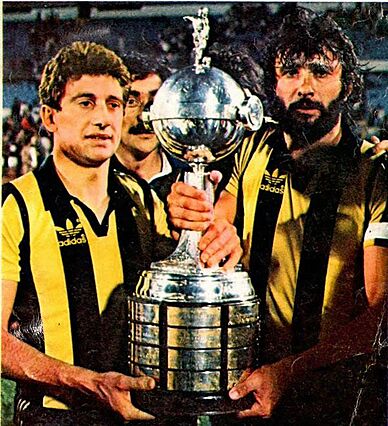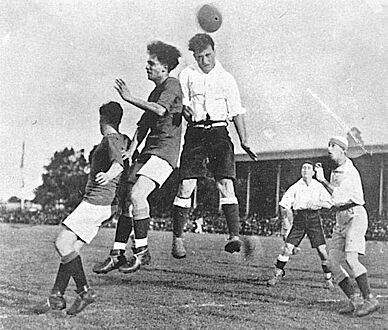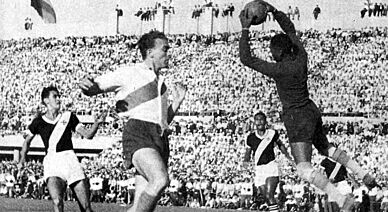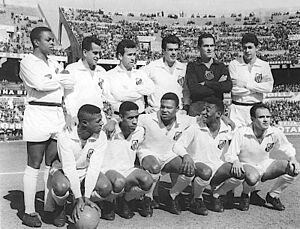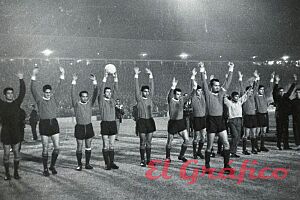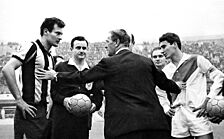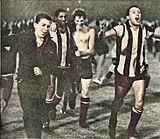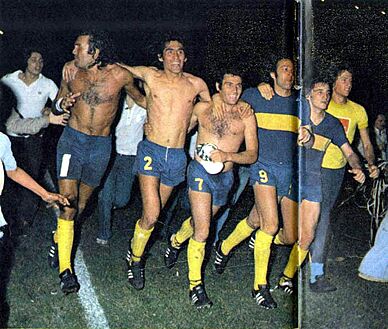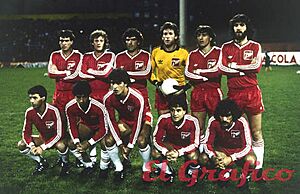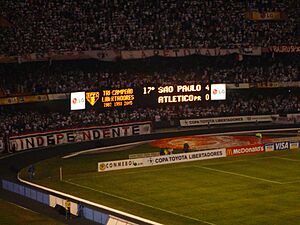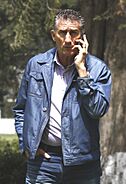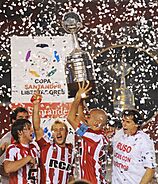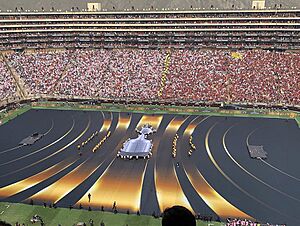History of the Copa Libertadores facts for kids
The Copa Libertadores is the biggest international football club competition in South America. It's like the Champions League for South American teams! Over the years, 25 teams from seven countries have won this amazing tournament. It's full of legendary matches, famous players, and incredible teams.
Think of Peñarol winning in 1960, or Coutinho and Pelé showing off their skills with Santos. There's also Estudiantes with their surprising wins in the late 1960s, and Club Atlético Independiente becoming super champions.
More recently, people still talk about Juan Carlos Lorenzo's Boca Juniors, Flamengo winning with Zico leading the way, and René Higuita's amazing saves for Olimpia. Don't forget São Paulo's "dream team" coached by Telê Santana, and Carlos Bianchi's success with Boca Juniors and Vélez Sársfield.
Football came to South America in different ways. In Argentina, British immigrants brought it to Buenos Aires in the late 1800s. In Brazil, an expat named Charles William Miller introduced the sport. British visitors brought football to Chile's ports like Valparaíso. And a Dutchman named William Paats brought it to Paraguay in 1888, helping to start a classic South American club.
Contents
How the Copa Libertadores Began
The idea for a big South American club competition had been around for a long time. In the 1930s and 1940s, teams from Argentina and Uruguay played each other in the Copa Ricardo Aldao. This was like a mini-championship between their best teams.
Then, in 1948, the "Campeonato Sudamericano de Campeones" was played in Chile. Vasco da Gama from Brazil won it. This tournament was a "prototype" for the Copa Libertadores. It even inspired the creation of the European Cup (now the Champions League) in Europe a few years later!
Another competition, the "Copa do Atlântico", was held in 1956, but it only had one edition and no champion was crowned.
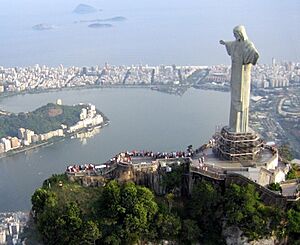
In 1958, football leaders met in Rio de Janeiro. They talked about creating a South American club championship. Argentina and Brazil supported the idea. Uruguay was against it at first, because they thought it would hurt national team tournaments.
But on October 8, 1958, João Havelange announced the creation of the "Copa de Campeones de America". This was meant to be South America's version of the European Cup. The winners of both cups could then play each other to decide the "best club team of the world" in the Intercontinental Cup.
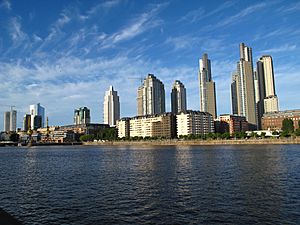
Finally, on March 5, 1959, at a meeting in Buenos Aires, the Chilean delegates pushed for the tournament to be created. It was approved! Only Uruguay voted against it. The tournament was named Copa Libertadores de America to honor the "heroes of South American history". These heroes were important leaders like Simón Bolívar and José de San Martín who helped South American countries become independent.
The first edition of the tournament was played with seven teams. The president of Peñarol, Washington Cataldi, later said that they were pioneers in starting the cup. He also helped make it bigger, so more teams could play.
First Decade: 1960–69
Peñarol's Early Success
The first Copa Libertadores in 1960 had seven national champions. These included Bahia (Brazil), Jorge Wilstermann (Bolivia), Millonarios (Colombia), Olimpia (Paraguay), Peñarol (Uruguay), San Lorenzo (Argentina), and Universidad de Chile (Chile).
Carlos Borges of Peñarol scored the very first goal of the tournament. His teammate, the legendary Alberto Spencer, scored the first three-goal "hat-trick." Peñarol started strong, beating Jorge Wilstermann 7–1. They went on to face San Lorenzo in the semifinals. After two draws, Peñarol won the tie-breaking match 2–1.
In the final, Peñarol played Olimpia. Peñarol won the first match 1–0 in Montevideo. In the second match in Paraguay, Luis Cubilla scored a late goal to tie the game 1–1. This made Peñarol the first-ever champions of the competition!
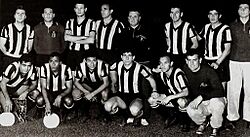
In 1961, Peñarol defended their title. They beat Universitario 5–0 and then defeated Olimpia again in the semifinals. In the final, they faced Brazilian giants Palmeiras. Peñarol won the first game 1–0 with another late goal from Alberto Spencer. They tied the second game 1–1 to win their second straight title. Many people saw Peñarol's early wins as "historical justice" because their leaders helped create the tournament.
1962–63: The Santasticos
Peñarol was very strong, but then came Santos, led by the Brazilian football superstar Pelé. Santos had won the Brazilian championship in 1961. This allowed them to play in the Copa Libertadores.
The 1962 Copa Libertadores became famous because of Santos's amazing football. Their team, known as the ballet blanco, included players like Pelé, Coutinho, and Zito. Some people even say they were the best club team of all time! Santos won their group easily, even beating Cerro 9–1. They defeated Universidad Católica in the semifinals.
In the 1962 final, Santos met the defending champions, Peñarol. Pelé scored two goals in the playoff match to help Santos win their first title. This was the first time a Brazilian club won the Copa Libertadores.
As defending champions, Santos automatically went to the semifinals in 1963. They kept their title in a spectacular way, with big wins over Botafogo and Boca Juniors. Pelé helped Santos beat a strong Botafogo team that had legends like Garrincha. In the second game, Pelé scored three goals, and Santos crushed Botafogo 4–0.
In their second final in a row, Santos won the first game 3–2 against Boca Juniors. Then, they beat Boca Juniors 2–1 in their home stadium, La Bombonera. This made Santos the first Brazilian team to win the Copa Libertadores in Argentina!
1964–69: Argentina Takes Over
In 1964, an Argentine team finally won the tournament. Independiente knocked out the powerful Santos in the semifinals. Then, they became the first Argentine team to win the competition by beating Nacional from Uruguay in the final.
Independiente successfully defended their title in 1965. In 1966, Peñarol won their third title by defeating River Plate in a playoff.
River Plate's loss to Peñarol in 1966 was a big shock. After the game, some Banfield fans threw a chicken (painted with River Plate's colors) onto the field to make fun of them. Since then, River Plate players have sometimes been called gallinas (chickens) when they lose important matches.
In 1967, Racing Club, another Argentine team, won the title. They beat Nacional 2–1 in a playoff.
Starting in 1968, a new Argentine team, Estudiantes, began to dominate. Estudiantes was not one of the traditional "big five" teams in Argentina. They won their first Argentine league title in 1967. Then, they went on to win the Copa Libertadores in 1968, beating Palmeiras in the final.
Coached by Osvaldo Zubeldía and with star players like Carlos Bilardo and Juan Ramón Verón, Estudiantes won the Copa Libertadores again in 1969 and 1970. They became the first team to win the title three years in a row! Estudiantes had a unique style, focusing on being very fit and winning at all costs. They were known as the pincharratas.
1970–79: Argentina's Decade
The 1970s were mostly won by Argentine clubs. In 1971, Nacional from Uruguay won the tournament, beating Estudiantes.
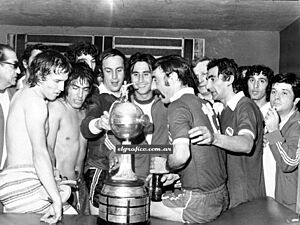
Independiente then created an amazing winning team with players like Francisco Sa, José Omar Pastoriza, Ricardo Bochini, and Daniel Bertoni. They won four titles in a row: 1972, 1973, 1974, and 1975! Their home stadium, La Doble Visera, was a very tough place for visiting teams to play.
In 1972, Independiente beat Universitario de Deportes from Peru in the final. Universitario was the first team from the Pacific coast to reach the final. Independiente won 2–1 in the second game. They defended their title in 1973 against Colo-Colo and in 1974 against São Paulo. In 1975, they beat Unión Española to win their fourth straight title.
Independiente's amazing winning streak ended in 1976 when they were beaten by fellow Argentine club River Plate. However, River Plate then lost to Cruzeiro from Brazil in the final. This was the first win for a Brazilian club in 13 years.
After losing in the 1963 final, Boca Juniors finally made their mark. Towards the end of the 1970s, the Xeneizes reached the final three years in a row. In 1977, Boca won their first title against defending champions Cruzeiro. The final went to a tense penalty shootout, which Boca won.
Boca Juniors won the trophy again in 1978, beating Deportivo Cali from Colombia 4–0 in the second game. In 1979, Boca Juniors hoped to win their third title in a row. But Olimpia from Paraguay stopped their dream. Olimpia won the final, becoming the first (and so far, only) Paraguayan team to lift the Copa. This win also ended Argentina's dominance of the past 15 years.
Before 1979, only teams from Argentina, Brazil, and Uruguay had won the title. Olimpia's win was a big moment for other South American countries.
1980–89
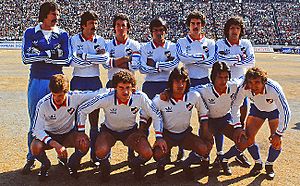
In 1980, Nacional won their second cup, beating Internacional. Even though Brazil is a football powerhouse, 1981 marked only the fourth title won by a Brazilian club. Flamengo, led by stars like Zico and Júnior, won their first title, beating Cobreloa from Chile.
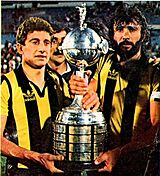
After 16 years, Peñarol won the cup for the fourth time in 1982. They beat defending champions Flamengo and then Cobreloa in the final. Grêmio from Brazil made history by defeating Peñarol to become champion in 1983. In 1984, Independiente won their seventh cup, a record that still stands today! They beat Grêmio in the final.
Another team from the Pacific coast, América from Colombia, reached three finals in a row (1985, 1986, and 1987). But they couldn't win any of them. In 1985, Argentinos Juniors, a smaller club from Buenos Aires, surprised everyone. They beat Independiente and then won their first title by beating América de Cali in a penalty shootout.
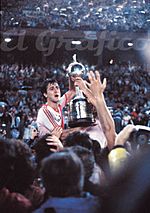
After losing two previous finals, River Plate finally won their first title in 1986. They beat América de Cali in both games of the final.
Peñarol won the Cup for the fifth time in 1987, beating América de Cali again in a playoff. Forward Diego Aguirre scored in extra time to win the Cup. América de Cali reached the final for the third year in a row but was still the runner-up.
This was Peñarol's last big international win for a while. Their rivals, Nacional, also won one last cup in 1988 before Uruguayan football saw a decline.
In 1989, a Pacific team finally broke the dominance of the traditional powers. Atlético Nacional from Colombia won the final, becoming the first team from Colombia to win the tournament. Atlético Nacional faced Olimpia. They lost the first game 2–0 in Paraguay. The second game was played in Bogota, and Atlético Nacional won 2–0, tying the series. They won the cup after a long penalty shootout. Goalkeeper René Higuita became a legend by saving four penalties and even scoring one himself! This was also the first time that no club from Argentina, Uruguay, or Brazil reached the final.
1990–99
Luis Cubilla, who led Olimpia to the 1979 title, returned to the club in 1988. With players like Ever Hugo Almeida and Raul Vicente Amarilla, Olimpia reached the 1990 Copa Libertadores final. They defeated defending champions Atlético Nacional in the semifinals. In the final, Olimpia beat Barcelona from Ecuador 3–1 to win their second title.
Olimpia reached the 1991 final again, but this time they lost to Colo-Colo from Chile. Led by coach Mirko Jozić, the Chilean team beat Olimpia 3–0.
In 1992, São Paulo became an international powerhouse. Coach Telê Santana used young players and a fast, exciting style of football. Led by stars like Zetti, Müller, and Raí, São Paulo beat Newell's Old Boys from Argentina to start a new era. In 1993, São Paulo successfully defended their title, beating Universidad Católica from Chile in the final.
São Paulo was the first club since Boca Juniors in 1978 to win two Copa Libertadores in a row. However, in 1994, they reached another final but lost to Vélez Sársfield from Argentina in a penalty shootout.
With a strong team and goals from Jardel and Paulo Nunes, Grêmio won the trophy again in 1995. They beat Atlético Nacional, who still had René Higuita as goalkeeper. Jardel was the top scorer with 12 goals.
In 1996, players like Hernán Crespo and Enzo Francescoli helped River Plate win their second title. They defeated América de Cali in a rematch of the 1986 final.
The Copa Libertadores stayed in Brazil for the rest of the 1990s, with Cruzeiro, Vasco da Gama, and Palmeiras winning. In 1997, Cruzeiro beat Peruvian club Sporting Cristal in the final. Vasco da Gama easily defeated Barcelona SC to win their first title in 1998.
The decade ended with Palmeiras and Deportivo Cali, both previous runners-up, playing for their first title in 1999. The final was a dramatic match that went to penalties. Coach Luiz Felipe Scolari led Palmeiras to a 4–3 win in São Paulo.
This decade was a big turning point. Teams from Brazil started to win more often. In the 1990s, Brazilian clubs reached eight finals and won six titles.
From 1998 onwards, Toyota sponsored the Copa Libertadores, and it was called the Copa Toyota Libertadores. Also, Mexican clubs started to take part in the competition. The tournament expanded to 34 teams, and teams received money for advancing in the competition.
2000–09: A Decade of Comebacks
In 2000, Boca Juniors returned to the top of South American football after 22 years. Led by coach Carlos Bianchi, and with amazing players like Mauricio Serna, Juan Roman Riquelme, and Martín Palermo, Boca became one of the world's best clubs. They started this new era by defeating defending champions Palmeiras in the final. On their way to the final, they also beat their big rivals River Plate.
Boca Juniors won again in 2001, beating Palmeiras in the semifinals and Cruz Azul from Mexico in the final. Cruz Azul won the second game 1–0, so the final went to a penalty shootout. Boca Juniors won 3–1. Cruz Azul was the first Mexican club to reach the final.
However, Boca Juniors couldn't win three titles in a row. In 2002, Olimpia eliminated them in the quarterfinals. Led by coach Nery Pumpido, Olimpia went on to win their third trophy, beating São Caetano in the final.
The 2003 tournament was very exciting, with many great teams and some surprising ones. Santos, with young stars like Robinho and Diego, played exciting football, reminding people of Pelé's generation. Boca Juniors, with new stars like Carlos Tevez, met Santos in a rematch of the 1963 final. Boca won both games, getting revenge for their 1963 loss. Carlos Bianchi won his fourth Copa, becoming the most successful coach in the competition's history.
Boca reached their fourth final in five years in 2004, but they lost to Once Caldas from Colombia. Once Caldas, playing a defensive style, became the second Colombian team to win the competition.
In 2005, São Paulo made a great comeback and reached the final against Atlético Paranaense. This was the first time two teams from the same country played in the Copa Libertadores final. São Paulo won their third title. The 2006 final was also an all-Brazilian match, with São Paulo playing Internacional. Internacional won their first title, beating São Paulo 2–1 in the first game and drawing 2–2 in the second.

Internacional's rivals, Grêmio, surprised many by reaching the 2007 final with a young team. But Boca Juniors, with experienced players, won their sixth title. Boca Juniors, managed by Miguel Ángel Russo and led by Juan Roman Riquelme, beat Grêmio 5–0 over two games. Riquelme was Boca Juniors' top scorer with 8 goals.
In 2008, LDU Quito became the first team from Ecuador to win the Copa Libertadores. They defeated Fluminense in a penalty shootout. Goalkeeper José Francisco Cevallos was a hero, saving three penalties.
The biggest comeback of the decade happened in the 2009 Copa Libertadores. Estudiantes de La Plata, led by Juan Sebastián Verón, won their fourth title. This was 39 years after their successful team of the 1960s (which included Juan Sebastián's father, Juan Ramón). Estudiantes won by beating Cruzeiro 2–1 in the second game.
2010–19
The 2010s started with Brazilian clubs winning for four years in a row. In 2010, Internacional won their second Copa Libertadores, beating Guadalajara from Mexico. Guadalajara was the second Mexican club to reach a final.
In 2011, led by rising star Neymar, Santos won their third trophy, their first since the 1960s. They beat Peñarol 2–1 in the second game after a 0–0 draw in the first.
In 2012, Corinthians won their first Copa Libertadores, and they did it without losing a single game! They beat Boca Juniors 2–0 in the second game after a 1–1 draw in the first.
In 2013, Atlético Mineiro, with superstar Ronaldinho, won their first title. They beat Paraguayan Olimpia in a penalty shootout after tying the game 2–0 in the second leg. Goalkeeper Victor saved a crucial penalty.
The Brazilian winning streak ended in 2014 when San Lorenzo de Almagro won their first title. They beat Paraguayan Club Nacional. Until then, San Lorenzo was the only one of Argentina's "Big Five" clubs that hadn't won the competition. The team was coached by Edgardo Bauza, who won his second Libertadores.
River Plate won their third title in 2015, defeating Mexican Tigres UANL (the third Mexican club to reach a final). River Plate's path to the final included a controversial series against Boca Juniors, where Boca was disqualified.
Colombian team Atlético Nacional won their second continental title in 2016. They beat Ecuador's Independiente del Valle 2–1. The Ecuadorian team had surprised everyone by eliminating both River Plate and Boca Juniors.
Grêmio won the competition for the third time in 2017, defeating Lanús from Argentina. Grêmio won both games for a 3–1 total score. The Brazilian team was managed by Renato Gaúcho, who had also won the Copa Libertadores as a player in 1983.
In 2018, River Plate beat their archrivals Boca Juniors 3–1 in a special return game played in Madrid, Spain. This happened because of security issues in Buenos Aires before the match. This was the last final to be played over two games. Starting in 2019, the final would be a single match at a neutral location.
The 2019 edition was the first Copa Libertadores final to be played as a single match in a neutral venue, the Estadio Monumental in Lima, Peru.
In the final, Brazilian Flamengo beat reigning champions River Plate 2–1. Flamengo's forward Gabriel Barbosa scored two goals in the last three minutes to win the game. Because of this dramatic ending, the match is remembered as "one of the most dramatic finals of all time."
2020–onwards
The new decade started with Brazilian teams dominating the first two editions. In 2020, Palmeiras won their second trophy, beating their state rivals Santos 1–0 with a late goal.
Palmeiras won their third Copa Libertadores title in 2021, becoming the first team to win two Libertadores in the same year! They defeated Flamengo 2–1 after extra time, with another late winning goal.
See also
- Records and statistics of the Copa Libertadores
- List of Copa Libertadores finals
- Copa Libertadores de América Topscorers


